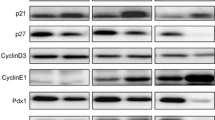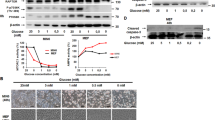Abstract
Chronic hyperglycemia (HG) promotes pancreatic islet dysfunction which leads to the onset of T2DM. This study is aimed at defining regulatory roles of Rac1, a small G-protein, in the activation of p53 and ATM kinase in pancreatic β-cells, under the duress of HG conditions. We report significant stimulatory effects of HG (20 mM; 24 h) on p53 activation in INS-1 832/13 cells, normal rodent and human islets. Pharmacological inhibition of Rac1 (EHT1864 or NSC23766) significantly suppressed HG-induced p53 activation in INS-1 832/13 cells and rat islets, suggesting novel roles for this small G-protein in the activation of p53. Inhibition of Rac1 geranylgeranylation with simvastatin or GGTI-2147, significantly attenuated HG-induced p53 activation, suggesting requisite roles for this signaling step in HG-mediated effects on β-cells. HG-induced p53 activation was also suppressed by SB203580, a known inhibitor of p38MAPK. Additionally, we observed increased activation of ATM kinase under HG conditions, which was blocked in presence of EHT1864. Furthermore, pharmacological inhibition of ATM kinase (KU55933) reduced activation of ATM kinase, but not p53, suggesting that HG-mediated activation of p53 and ATM could represent independent pro-apoptotic events. In conclusion, these data indicate that sustained activation of Rac1-p38MAPK signaling axis leads to activation of p53 leading to β-cell dysfunction under the duress of chronic hyperglycemic conditions.








Similar content being viewed by others
Abbreviations
- ATM kinase:
-
Ataxia telangiectasia mutated kinase
- GAPs:
-
GTPase-activating proteins
- GEFs:
-
Guanine nucleotide exchange factors
- GTP:
-
Guanosine triphosphate
- GGTI:
-
Geranylgeranyl transferase inhibitor
- GSIS:
-
Glucose-stimulated insulin secretion
- HG:
-
High glucose
- LG:
-
Low glucose
- Nox2:
-
NADPH oxidase 2
- p38MAPK:
-
p38 mitogen activated protein kinase
- Rac1:
-
Ras-related C3 botulinum toxin substrate 1
- ROS:
-
Reactive oxygen species
- T2DM:
-
Type 2 diabetes mellitus
- ZDF:
-
Zucker diabetic fatty rat
- ZLC:
-
Zucker lean control
References
Hedeskov CJ (1980) Mechanism of glucose-induced insulin secretion. Physiol Rev 60(2):442–509
Komatsu M, Takei M, Ishii H, Sato Y (2013) Glucose-stimulated insulin secretion: a newer perspective. J Diabetes Investig 4(6):511–516. doi:10.1111/jdi.12094
Asahara S, Shibutani Y, Teruyama K, Inoue HY, Kawada Y, Etoh H, Matsuda T, Kimura-Koyanagi M, Hashimoto N, Sakahara M, Fujimoto W, Takahashi H, Ueda S, Hosooka T, Satoh T, Inoue H, Matsumoto M, Aiba A, Kasuga M, Kido Y (2013) Ras-related C3 botulinum toxin substrate 1 (RAC1) regulates glucose-stimulated insulin secretion via modulation of F-actin. Diabetologia 56(5):1088–1097. doi:10.1007/s00125-013-2849-5
Kowluru A (2010) Small G proteins in islet beta-cell function. Endocr Rev 31(1):52–78. doi:10.1210/er.2009-0022
Wang Z, Thurmond DC (2009) Mechanisms of biphasic insulin-granule exocytosis: roles of the cytoskeleton, small GTPases and SNARE proteins. J Cell Sci 122(Pt 7):893–903. doi:10.1242/jcs.034355
Jayaram B, Syed I, Kyathanahalli CN, Rhodes CJ, Kowluru A (2011) Arf nucleotide binding site opener [ARNO] promotes sequential activation of Arf6, Cdc42 and Rac1 and insulin secretion in INS 832/13 beta-cells and rat islets. Biochem Pharmacol 81(8):1016–1027. doi:10.1016/j.bcp.2011.01.006
Kowluru A (2011) Friendly, and not so friendly, roles of Rac1 in islet beta-cell function: lessons learnt from pharmacological and molecular biological approaches. Biochem Pharmacol 81(8):965–975. doi:10.1016/j.bcp.2011.01.013
Kowluru A, Kowluru RA (2015) Protein prenylation in islet beta-cell function in health and diabetes: putting the pieces of the puzzle together. Biochem Pharmacol 98(3):363–370. doi:10.1016/j.bcp.2015.07.004
Sidarala V, Veluthakal R, Syeda K, Kowluru A (2015) EHT 1864, a small molecule inhibitor of Ras-related C3 botulinum toxin substrate 1 (Rac1), attenuates glucose-stimulated insulin secretion in pancreatic beta-cells. Cell Signal 27(6):1159–1167. doi:10.1016/j.cellsig.2015.02.020
Veluthakal R, Madathilparambil SV, McDonald P, Olson LK, Kowluru A (2009) Regulatory roles for Tiam1, a guanine nucleotide exchange factor for Rac1, in glucose-stimulated insulin secretion in pancreatic beta-cells. Biochem Pharmacol 77(1):101–113. doi:10.1016/j.bcp.2008.09.021
Veluthakal R, Tunduguru R, Arora DK, Sidarala V, Syeda K, Vlaar CP, Thurmond DC, Kowluru A (2015) VAV2, a guanine nucleotide exchange factor for Rac1, regulates glucose-stimulated insulin secretion in pancreatic beta cells. Diabetologia. doi:10.1007/s00125-015-3707-4
Kowluru A, Kowluru RA (2014) Phagocyte-like NADPH oxidase [Nox2] in cellular dysfunction in models of glucolipotoxicity and diabetes. Biochem Pharmacol 88(3):275–283. doi:10.1016/j.bcp.2014.01.017
Pick E (2014) Role of the Rho GTPase Rac in the activation of the phagocyte NADPH oxidase: outsourcing a key task. Small GTPases 5:e27952. doi:10.4161/sgtp.27952
Pi J, Collins S (2010) Reactive oxygen species and uncoupling protein 2 in pancreatic beta-cell function. Diabetes Obes Metab 12(Suppl 2):141–148. doi:10.1111/j.1463-1326.2010.01269.x
Morgan D, Rebelato E, Abdulkader F, Graciano MF, Oliveira-Emilio HR, Hirata AE, Rocha MS, Bordin S, Curi R, Carpinelli AR (2009) Association of NAD(P)H oxidase with glucose-induced insulin secretion by pancreatic beta-cells. Endocrinology 150(5):2197–2201. doi:10.1210/en.2008-1149
Syed I, Kyathanahalli CN, Kowluru A (2011) Phagocyte-like NADPH oxidase generates ROS in INS 832/13 cells and rat islets: role of protein prenylation. Am J Physiol Regul Integr Comp Physiol 300(3):R756–R762. doi:10.1152/ajpregu.00786.2010
Newsholme P, Morgan D, Rebelato E, Oliveira-Emilio HC, Procopio J, Curi R, Carpinelli A (2009) Insights into the critical role of NADPH oxidase(s) in the normal and dysregulated pancreatic beta cell. Diabetologia 52(12):2489–2498. doi:10.1007/s00125-009-1536-z
Syed I, Kyathanahalli CN, Jayaram B, Govind S, Rhodes CJ, Kowluru RA, Kowluru A (2011) Increased phagocyte-like NADPH oxidase and ROS generation in type 2 diabetic ZDF rat and human islets: role of Rac1-JNK1/2 signaling pathway in mitochondrial dysregulation in the diabetic islet. Diabetes 60(11):2843–2852. doi:10.2337/db11-0809
Subasinghe W, Syed I, Kowluru A (2011) Phagocyte-like NADPH oxidase promotes cytokine-induced mitochondrial dysfunction in pancreatic beta-cells: evidence for regulation by Rac1. Am J Physiol Regul Integr Comp Physiol 300(1):R12–R20. doi:10.1152/ajpregu.00421.2010
Sidarala V, Veluthakal R, Syeda K, Vlaar C, Newsholme P, Kowluru A (2015) Phagocyte-like NADPH oxidase (Nox2) promotes activation of p38MAPK in pancreatic beta-cells under glucotoxic conditions: evidence for a requisite role of Ras-related C3 botulinum toxin substrate 1 (Rac1). Biochem Pharmacol 95(4):301–310. doi:10.1016/j.bcp.2015.04.001
Bulavin DV, Saito S, Hollander MC, Sakaguchi K, Anderson CW, Appella E, Fornace AJ Jr (1999) Phosphorylation of human p53 by p38 kinase coordinates N-terminal phosphorylation and apoptosis in response to UV radiation. EMBO J 18(23):6845–6854. doi:10.1093/emboj/18.23.6845
Karunakaran S, Saeed U, Mishra M, Valli RK, Joshi SD, Meka DP, Seth P, Ravindranath V (2008) Selective activation of p38 mitogen-activated protein kinase in dopaminergic neurons of substantia nigra leads to nuclear translocation of p53 in 1-methyl-4-phenyl-1,2,3,6-tetrahydropyridine-treated mice. J Neurosci 28(47):12500–12509. doi:10.1523/JNEUROSCI.4511-08.2008
Sanchez-Prieto R, Rojas JM, Taya Y, Gutkind JS (2000) A role for the p38 mitogen-acitvated protein kinase pathway in the transcriptional activation of p53 on genotoxic stress by chemotherapeutic agents. Cancer Res 60(9):2464–2472
Joerger AC, Fersht AR (2008) Structural biology of the tumor suppressor p53. Annu Rev Biochem 77:557–582. doi:10.1146/annurev.biochem.77.060806.091238
Joerger AC, Fersht AR (2010) The tumor suppressor p53: from structures to drug discovery. Cold Spring Harb Perspect Biol 2(6):a000919. doi:10.1101/cshperspect.a000919
Yu J, Zhang L (2005) The transcriptional targets of p53 in apoptosis control. Biochem Biophys Res Commun 331(3):851–858. doi:10.1016/j.bbrc.2005.03.189
Liu D, Xu Y (2011) p53, oxidative stress, and aging. Antioxid Redox Signal 15(6):1669–1678. doi:10.1089/ars.2010.3644
Bode AM, Dong Z (2004) Post-translational modification of p53 in tumorigenesis. Nat Rev Cancer 4(10):793–805. doi:10.1038/nrc1455
Lambert PF, Kashanchi F, Radonovich MF, Shiekhattar R, Brady JN (1998) Phosphorylation of p53 serine 15 increases interaction with CBP. J Biol Chem 273(49):33048–33053
Loughery J, Cox M, Smith LM, Meek DW (2014) Critical role for p53-serine 15 phosphorylation in stimulating transactivation at p53-responsive promoters. Nucleic Acids Res 42(12):7666–7680. doi:10.1093/nar/gku501
Hickson I, Zhao Y, Richardson CJ, Green SJ, Martin NM, Orr AI, Reaper PM, Jackson SP, Curtin NJ, Smith GC (2004) Identification and characterization of a novel and specific inhibitor of the ataxia-telangiectasia mutated kinase ATM. Cancer Res 64(24):9152–9159. doi:10.1158/0008-5472.CAN-04-2727
Yoshida M, Shiojima I, Ikeda H, Komuro I (2009) Chronic doxorubicin cardiotoxicity is mediated by oxidative DNA damage-ATM-p53-apoptosis pathway and attenuated by pitavastatin through the inhibition of Rac1 activity. J Mol Cell Cardiol 47(5):698–705. doi:10.1016/j.yjmcc.2009.07.024
Oleson BJ, Broniowska KA, Schreiber KH, Tarakanova VL, Corbett JA (2014) Nitric oxide induces ataxia telangiectasia mutated (ATM) protein-dependent gammaH2AX protein formation in pancreatic beta cells. J Biol Chem 289(16):11454–11464. doi:10.1074/jbc.M113.531228
Syed I, Jayaram B, Subasinghe W, Kowluru A (2010) Tiam1/Rac1 signaling pathway mediates palmitate-induced, ceramide-sensitive generation of superoxides and lipid peroxides and the loss of mitochondrial membrane potential in pancreatic beta-cells. Biochem Pharmacol 80(6):874–883. doi:10.1016/j.bcp.2010.05.006
Veluthakal R, Sidarala V, Kowluru A (2016) NSC23766, a known inhibitor of Tiam1-Rac1 signaling module, prevents the onset of Type 1 diabetes in the NOD mouse model. Cell Physiol Biochem 39(2):760–767. doi:10.1159/000445666
Kang S, Kim ES, Moon A (2009) Simvastatin and lovastatin inhibit breast cell invasion induced by H-Ras. Oncol Rep 21(5):1317–1322
Veluthakal R, Kaur H, Goalstone M, Kowluru A (2007) Dominant-negative alpha-subunit of farnesyl- and geranyltransferase inhibits glucose-stimulated, but not KCl-stimulated, insulin secretion in INS 832/13 cells. Diabetes 56(1):204–210. doi:10.2337/db06-0668
Green DR, Kroemer G (2009) Cytoplasmic functions of the tumour suppressor p53. Nature 458(7242):1127–1130. doi:10.1038/nature07986
Liang SH, Clarke MF (1999) The nuclear import of p53 is determined by the presence of a basic domain and its relative position to the nuclear localization signal. Oncogene 18(12):2163–2166. doi:10.1038/sj.onc.1202350
O’Brate A, Giannakakou P (2003) The importance of p53 location: nuclear or cytoplasmic zip code? Drug Resist Updat 6(6):313–322
Young PR, McLaughlin MM, Kumar S, Kassis S, Doyle ML, McNulty D, Gallagher TF, Fisher S, McDonnell PC, Carr SA, Huddleston MJ, Seibel G, Porter TG, Livi GP, Adams JL, Lee JC (1997) Pyridinyl imidazole inhibitors of p38 mitogen-activated protein kinase bind in the ATP site. J Biol Chem 272(18):12116–12121
Bakkenist CJ, Kastan MB (2003) DNA damage activates ATM through intermolecular autophosphorylation and dimer dissociation. Nature 421(6922):499–506. doi:10.1038/nature01368
Poitout V, Robertson RP (2008) Glucolipotoxicity: fuel excess and beta-cell dysfunction. Endocr Rev 29(3):351–366. doi:10.1210/er.2007-0023
Vitale I, Senovilla L, Galluzzi L, Criollo A, Vivet S, Castedo M, Kroemer G (2008) Chk1 inhibition activates p53 through p38 MAPK in tetraploid cancer cells. Cell Cycle 7(13):1956–1961. doi:10.4161/cc.7.13.6073
Lenzen S, Drinkgern J, Tiedge M (1996) Low antioxidant enzyme gene expression in pancreatic islets compared with various other mouse tissues. Free Radic Biol Med 20(3):463–466
Kim JY, Lee JS, Han YS, Lee JH, Bae I, Yoon YM, Kwon SM, Lee SH (2015) Pretreatment with lycopene attenuates oxidative stress-induced apoptosis in human mesenchymal stem cells. Biomol Ther (Seoul) 23(6):517–524. doi:10.4062/biomolther.2015.085
Acknowledgements
This work was supported by grants to A.K from the Department of Veterans Affairs (Merit Review Program) and National Institutes of Health, and a Research Stimulation Award from Wayne State University. A.K is the recipient of a Senior Research Career Scientist Award from the Department of Veterans Affairs (13S-RCS-006). VS received a Pre-Doctoral Fellowship from Graduate School at Wayne State University. The authors thank Drs. Anil K. Chekuri and Anil Poudel for contributions and support throughout these studies.
Author contributions
Vaibhav Sidarala performed the experimental work, analyzed the data and edited the manuscript prior to publication. Anjan Kowluru designed the studies, wrote the manuscript and edited prior to submission.
Author information
Authors and Affiliations
Corresponding author
Ethics declarations
Conflict of interest
None.
Rights and permissions
About this article
Cite this article
Sidarala, V., Kowluru, A. Exposure to chronic hyperglycemic conditions results in Ras-related C3 botulinum toxin substrate 1 (Rac1)-mediated activation of p53 and ATM kinase in pancreatic β-cells. Apoptosis 22, 597–607 (2017). https://doi.org/10.1007/s10495-017-1354-6
Published:
Issue Date:
DOI: https://doi.org/10.1007/s10495-017-1354-6




